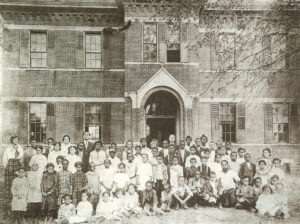Please note, this information was complied by an unknown author. Last updated, information corrected was in 2006. If you notice inaccuracies please contact our staff so we can make appropriate changes – info@clintoncountyhistory.org
Virginia Military Land Grants and George Clinton:
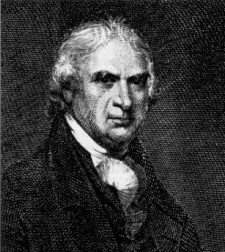
Vice President George Clinton, for whom Clinton County is named. © Clinton County Historical Society. All rights reserved.
In 1785, the area that was to become Ohio was part of the Virginia Military District, land being used as payment to military veterans from Virginia for their service during the American Revolution. The opening of the Northwest Territory in 1787 brought many settlers to the “new west” of the United States. When the earliest settlers came to Clinton County about 1798, they found the soil very fertile and al
most the entire area covered by massive forests and tangled shrubs. By March 1, 1810 Clinton County was officially established. The new county was named “Clinton” in honor of U.S. Vice President Georege Clinton. That same year the county’s population was recorded as 2,674. Clinton County was formed from land in portions of Warren and Highland Counties. There were originally only three townships, Richland, Chester, and Vernon. Currently there are thirteen townships and approximately a population of 42,000. After much research, three men are credited with settling Clinton County although there are no records of which arrived first or the exact year.The men are said to have arrived sometime between 1797 and 1799. They include Morgan Van Meter, Amos Wilson, and David Sewell.
The County Seat:
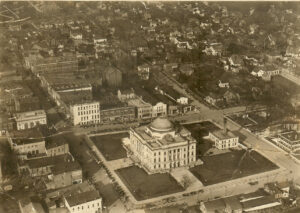
Undated arial view of Clinton County’s third courthouse and the county seat of Wilmington. © Clinton County Historical Society. All rights reserved.
Wilmington, the county seat of Clinton County was plotted and laid out between 1810 and 1812 as a result of land donated by David Faulker and Joseph Doan. The town of Wilmington was laid out by George McManis, Director for Clinton County, and consisted of 16 squares of eight lots each – numbering from 1 to 128 – with lots 58 and 73 specifically set aside for public grounds. The most expensive lots sold for $100 and the cheapest sold for $4.25. This area was originally known as Clinton in 1801, but in September of that year the name was changed to Armenia. On December 31, 1810 the name was changed again to Mt. Pleasant. It was once again altered for a final time on February 10, 1811 to Wilmington. At that time also, it was ruled that any further name changes for the town would have to be authorized by the state legislature.
Courthouse History and The Society of the Friends (Quakers):
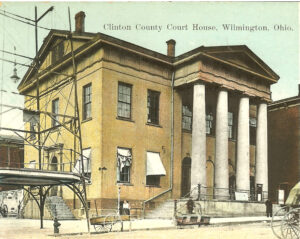
Clinton County’s second courthouse building. Previously located on the spot of what is now 27 North South Street in Wilmington OH. © Clinton County Historical Society. All rights reserved.
Clinton County has witnessed the building of three separate Courthouses to date. With the most recent and current Courthouse, located in the county seat, being dedicated on October 22, 1919. This structure cost $370,000 to construct and is a grand example of Beaux-Arts Classicism. Many of the county’s early residents were members of the Society of Friends (Quakers). They played an important role in the Underground Railroad during the 1830s, 1840s, 1850s, and 1860s, helping runaway slaves find freedom in the North. The Quaker community also established Wilmington College in 1870. From the earliest days of Clinton County to the present, farming has always been an integral part of the community. Corn and wheat were farmed and livestock such as hogs and cattle were raised. These, along with soybeans are still a major source of revenue.
Commerce in Clinton County:
One of the oldest companies established in Clinton County is the Champion Bridge Company. This company was started in 1875 and at that time produced wood, steel, and combination bridges. Today the Champion Bridge Company produces commercial and industrial buildings. Another company with a long history in Clinton County is the Liberty Savings Bank. Founded in Highland County in 1889, Liberty Savings Bank has continued to offer its services to Clinton County for over one hundred years. This year marks the centennial anniversary of another long running business in Clinton County. Buckley Brothers, created in 1903, offers grain, feed, and farm supplies to Clinton County. Another agricultural supply company is Clinton Landmark, Inc. Established in 1934 it is owned by the local farming community.
Large industry is also present in Clinton County. The list is so extensive it would be impossible to name them all. A few of these businesses include New Sabina Industries, American Showa Inc., the Ahresty Corporation, Ferno-Washington, and Airborne Express. It is not hard to figure out why industry is attracted to Clinton County. Clinton County offers access to highways, interstates, state routes, and railroads. There are four freight carriers and one local airport in Clinton County. There are three international airports located from thirty to sixty-five miles from Wilmington in Columbus, Cincinnati, and Dayton. All of these amenities have helped shape Clinton County into a diversified area that offers urban qualities in a rural atmosphere.
Public services in Clinton County include the Clinton County Airport, the National Weather Service, the Wilmington City Cab Service, the Wilmington Water Treatment Plant, and local fire departments and EMS squads. The Clinton County Airport offers both small and large aircraft for hobby and travelers. The National Weather Service is located in Wilmington and was established in 1994. The National Weather Service issues weather forecasts and warnings for the southwest half of Ohio, north central Kentucky, and southeast Indiana. Clinton County has fire departments in Blanchester, Chester Township, Clarksville, Clinton South Joint Fire District, Martinsville, Clinton-Highland Fire District, Port William, RSWW Joint Fire District 2, Wilmington, Leesburg and Massie Township.
Wilmington’s History:
The city of Wilmington is located in Union Township and is the county seat for Clinton County. Established March 1, 1810, the town of Wilmington has continued to grow and prosper in its nearly two hundred years of existence. Timothy Bennet is credited with being the first settler in the area arriving in March, 1801 and settling near Wilmington’s present day location. Following Bennet, was George Haworth, who settled in Union Township around 1803. In 1801 Nathan Linton arrived in Ohio and settled in Waynesville for a short time. In 1803 Linton also made Union township his home.
The beginnings of the educational system in Wilmington were similar to other efforts around Clinton County. The first school in Wilmington was a log schoolhouse built by Joseph Doan between 1810 and 1812. The first teacher at that school was Isaac Garretson. From 1810 until around 1840 other similar schools were in operation, but in 1840 a permanent structure was built in Wilmington. On April 1, 1853 the different schools of Wilmington were organized into one district.
In 1853 the first African American teacher in Wilmington, Charles Hurd, was hired to teach at Wilmington’s African American school called the Midland building. The Midland school was built in 1884. In 1915 there were four schools in operation. The majority of older structures have regrettably made way for the progress of Wilmington’s current school system. The Smith Place building and Roger O’ Borror Middle School are examples of such buildings. Both schools and their architectural grandeur can still be recalled by many of Wilmington’s citizens.
Religion has always been an important part of Clinton County. Today there are over fifty churches in the county. Of the earliest churches the different denominations included Quaker, Methodist, Presbyterian, Baptist, Catholic, and Seventh-Day Adventist. The Wilmington Methodist Episcopal Church is credited with being the earliest church in Wilmington. In 1813 meetings were being held in the homes of its members and by 1818 the church purchased its first building. The Wilmington Presbyterian Church was established in 1823. On July 29, 1830 the members purchased a lot that would eventually become the site of their new church.
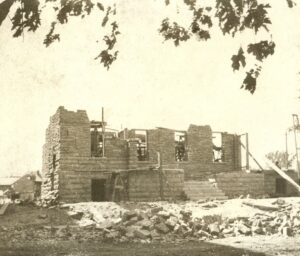
Wilmington Friends Church being built. Picture features the corner stone being laid. © Clinton County Historical Society. All rights reserved.
The Wilmington Friends Meeting was started in 1825 and it is believed that a church was built that same year. In 1828 Elias Hicks’s teaching gained popularity causing a separation with the Orthodox Quaker Church. Hicks’ followers became known as the Hicksites and gained control over the church in 1829. After 1829 the Hicksite movement dissolved and the church came under the control of the Orthodox Quakers. Central Christian Church was established between 1833 and 1834. The African Methodist Episcopal Church was organized in 1833 and by 1838 had constructed a log church. A brick building replaced the log structure in 1852.
St. Columbkille Catholic Church was organized in 1852 and by 1866, had started construction on their church. The First Baptist Church of Wilmington was started on August 6, 1853 and by July 1854 they dedicated their new building. The Wilmington Colored Baptist Church was established in 1870 and had finished building their church in 1872. The Seventh-Day Adventist organized in August 1887. Ada Chapel known as East Wilmington Mission was an offshoot of the Quaker Church. Lizzie R. Harvey was instrumental in its establishment, dating back to 1888.
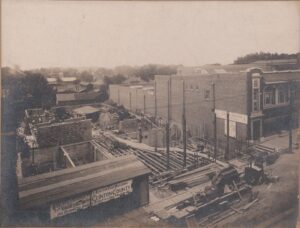
Construction of the Murphy Theater in Wilmington. © Clinton County Historical Society. All rights reserved.
Wilmington has many historic buildings dating from the early nineteenth and twentieth centuries. One of the most recognizable of these is the Clinton County Courthouse. Built in 1918, it is a Second Renaissance Revival style building. It boasts marble staircases and beautiful murals on the dome ceiling. Eighty-five years later these murals still depict the very heart of Clinton County, “Education, Agriculture, Medicine, and Industry”. Another famous Wilmington landmark is the Murphy Theatre built in 1918 by Charles Webb Murphy. Murphy was from Wilmington but best known as the owner of the Chicago Cubs.
Wilmington is also the proud home of Wilmington College. The Quaker community established Wilmington College in 1870. Wilmington College is a four-year private, liberal-arts college. It is best known for its agriculture program. Southern State Community College of Hillsboro also has a branch located in Wilmington. Southern State Community College is an accredited two-year college that offers associate degrees in several different fields of study.
Wilmington has changed considerably since its conception. The changes that have taken place throughout the county are best reflected through the city of Wilmington. While agriculture is still very important to Wilmington, industry is growing at an incredible rate. In recent years Wilmington has seen the expansion and addition of many businesses, Clinton Memorial Hospital, neighborhoods, schools, roads, hotels, restaurants, and retail stores. The intermingling of both the city and country make Wilmington an ideal place to live. Wilmington was chosen “Most Livable Neighborhood” by Cincinnati Magazine in the August 1995 issue. Wilmington was also chosen as best small town in Ohio in the book “The 100 Best Small Towns in America” by Norman Crampton.
There are multitudes of activities held through the year in Wilmington. Some of the most popular among children and adults are the Banana Split Festival in June, the Clinton County Fair in July, Wilmington’s fourth of July Celebration, the Clinton County Corn Festival in September and Oktoberfest in October, the Clinton County Home and Garden Show, and Wilmington’s Homespun Christmas. Caesar Creek State Park in Waynesville and Cowan Lake State Park in Wilmington offer recreation such as boating, fishing, swimming, camping, and hiking. The Murphy Theatre offers a wide variety of performances year round.
Blanchester’s History:
The village of Blanchester is located in Marion Township. The name of the town is derived from the founders Joseph and John Blancett. The Blancetts laid out Blanchester on March 6, 1832. Isaac Frazier and William H. Baldwin followed the Blancetts. Many of the original buildings in Blanchester were log buildings. In 1878 the population had grown to nine hundred residents.
The first school to be located within the boundaries of Blanchester was a log schoolhouse. This school was located on the south bank of Second Creek and taught by Benjamin Baldwin. For a short period of time Blanchester Public schools rented a space from the Universalist Church. Classes were held in the church until a new school was built shortly after the Civil War. In the 1880’s a brick school was built and used as the high school until 1925. The first graduate of this school was George W. Gustin in 1883. Throughout the early and mid twentieth century Blanchester schools went through extensive periods of demolition and reconstruction.
Early churches in Blanchester included Baptist, Methodist, Mennonite, and Catholic. The first church in Blanchester was the Free-Will Baptist Church. This group began meeting in the homes of its members until 1852 when a church was built. After 1913 this group was known as the First Baptist Church of Blanchester. The second church established in Blanchester was the First Universalist Church in 1852. The Blanchester Primitive Baptist Church organized around 1855 but was unable to maintain a following. The Rev. Michael O’ Donohue established the Most Holy Name of Jesus Catholic Church in 1873. The Blanchester Methodist Episcopal Church was established on December 23, 1878 later building a church in 1879. The Blanchester Friends Meeting was established in 1895 and the Mennonite Church organized in 1898 but they too were unable to maintain a following.
Among the first businesses in Blanchester were those of William Bundy and Joseph Blancett. William Bundy was Blanchester’s first blacksmith and Joseph Blancett owned the first general store. S. R. Nickerson started the Blanchester Herald newspaper on March 24, 1870. Nickerson operated the newspaper for a year and a half before selling it to James S. Turk. Turk changed the name to the Marion Independent and printed it until October 1, 1872. In 1890 the Merchants and Farmers Bank of Blanchester was established. They operated until the early 1900’s. The First National Bank was established in Blanchester on February 19, 1907.
Throughout the years, Blanchester has seen its economy boosted by local industry. One of the most influencing economic factors was the railroad industry. With several lines running through Blanchester the economic future of the small town looked bright. In 1849, construction started on the Hillsborough and Cincinnati Railroad which would run through Clinton County and Blanchester to Warren County. Construction was completed three years later on January 21, 1852. The Belpre and Cincinnati Railroad Company was established on March 8, 1845 later changing its name to Marietta and Cincinnati Railroad Company on August 12, 1854. A rail line from Marietta to Cincinnati was started in May 1851 and completed May 1, 1854. In 1860 the Hillsborough and Cincinnati Railroad was sold to the Marietta and Cincinnati Railroad company.
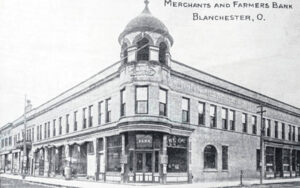
An early photo of Bindley Block; the Merchants and Farmers Bank building in Blanchester, which has been around for 124 years, according to the Blanchester Historical Society.
One of the most famous incidents in Blanchester’s history was the devastating fire on October 18, 1895. The fire started at 1:30 p.m. in a stable in W. W. Burke’s livery barn. The fire quickly spread through the business portion of the town. Blanchester’s only fire department at the time consisted of volunteers and a hand engine. Fire departments in Loveland and Lynchburg were deployed to help extinguish the fire. The fire lasted for six hours and when it had finally ended seventy-two buildings including the majority of the business district, a few homes, and barns were destroyed. Fortunately no one was killed or seriously injured in the fire. After the fire, the destroyed buildings were replaced with new brick buildings.
Currently Blanchester has several events throughout the year. In July, Blanchester holds their Fourth of July Family Fun Festival. In December Blanchester holds the Blanchester Hometown Christmas. Besides these events there are a number of small antique shops in downtown Blanchester. The town is also the home of the Blanchester Area Historical Society.
Sabina’s History:
Sabina is located in the central eastern part of Richland Township. Richland Township was believed to be named for the excellent soil quality in the area. Sabina was platted in 1830 by Warren Sabin. The name of the town is derived from Sabin’s name. Elisha Long was the first to build a log building in Sabina shortly before it was recognized as a town. Elijah Sabin is credited with building the first home within the confines of Sabina in 1830. Another early settler in the area before it was known as Sabina was Andrew Love. Love was also the first postmaster and tavern keeper in Sabina.
The earliest churches in Sabina consisted of Methodist and Quaker denominations. The Sabina Methodist Protestant’s organized in 1830 and built Bethel Church in 1841. Shortly after this, Bethel Church was destroyed in a fire. In 1860 a new brick building was built. Reverend William Smith started the Sabina Methodist Episcopal Church in 1850 and in 1862 a church was built. Reverend Charles Bundy started the Sabina African Methodist Episcopal Church January 1, 1879. In 1883 a church was built but two years later it was destroyed by fire. In 1886 the Sabina African Methodist-Protestant Church was rebuilt. The Sabina Friends organized between 1878 and 1879 and in 1880 a church was built.
Throughout the 1850’s, Sabina experienced a great deal of growth due to the railroads. The town was host to a number of businesses including banks, hotels, and stores. On February 16, 1875 Sabina Bank was opened for business. By 1898 both the Baltimore and Ohio Southwestern Railroad and the Cincinnati and Muskingum Valley Railroad ran through Sabina. Also in 1898 Sabina’s Municipal Water and Light Plant was established providing the residents of Sabina with municipal water and electricity.
Sabina has had several newspapers throughout its history. The Telegram was established on November 6, 1874 and operated until 1877. The Sabina News operated from 1877 until 1893 and from 1890 to 1893 The Record was also published. The News-Record was established in 1893 and The Tribune was established in 1894, both of these newspapers have long since vanished. Currently there is a small weekly publication of The Sabina Advertiser.
In June of 1905 Leota Haines sold her funeral business. The business continued operation under the name Littleton Funeral Home. It still operates today. On November 1, 1906 Sabina saw the establishment of the First National Bank of Sabina. In the 1930’s the population of Sabina had reached 1,296. Throughout the thirties and forties Sabina’s economy thrived. There were a number of groceries, restaurants, factories, and even a movie theatre. In 1927 Elmer McPherson and Bill Huff started McPherson Huff Tool Factory which prospered through the thirties. On July 11, 1938 Mechanics Tool and Forge Company was started. In 1944 Clinton Tool Company was established. Currently there are two major businesses in Sabina which include Palm Harbor Homes and New Sabina Industries.
While Sabina has recently experienced financial difficulties, it is clear the residents appreciate their past and hope for their future. Sabina has its own local museum and offers several events through the year.
Port William’s History:
Port William is located in Liberty Township. Originally named West Liberty the town was established in 1816 by John Unthank. Port William was officially platted on October 13, 1832. Garlan Johnson started the first store in 1829. John Unthank built the first mill in Port William in 1808 before Port William was founded. The mill dam was built by Unthank’s half-brother Hezekiah Hiatt. In 1825 Steel Taylor built a fulling-mill. The first blacksmith shop was established in 1828. In 1838 Jonathon Perkins started the first saloon in Port William. In 1846 Lewis Clark started the first woolen mill.
The Port William Methodist Protestant Church was organized in 1832. The men responsible for the founding of the church were Samuel Haynes and William Ireland. The first church was constructed out of logs and replaced in 1844 with a frame building. After the death of Samuel Haynes in 1864 the church’s following began to disappear. Later interest in the church was renewed and a new brick structure was built.
In 1837 the first school in Port William was constructed. This school was constructed by Daniel Bailey and made of brick. The second school in Port William was constructed in 1854. In 1902 Port William witnessed the construction of the first high school, just two years later in 1904 the high school saw its first graduating class. In 1952 a new grade school was built in Port William. The last graduating class of Liberty Local High School occurred in 1960. Sixteen years later the Port William elementary school also closed its doors.
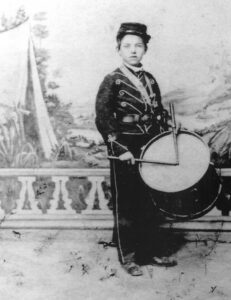
Gilbert “Little Gib” Vanzant. Youngest boy to serve in the Civil War. © Clinton County Historical Society. All rights reserved.
During the Civil War, Port William was very active in the recruiting of Union soldiers. Among the most recognized of these service men was a young boy named Gilbert VanZandt. In 1862, when recruiters came to the area, ten-year-old Gilbert VanZandt was hired to play drums as part of the recruitment program. Shortly after this Gilbert’s father enlisted and realized how serious young Gilbert was about joining the army. A special request was made to the war department to allow Gilbert to join. The request was granted and on September 3, 1862, after training, Gilbert VanZandt received his orders to march.
As a drummer boy for the army Gilbert had several important duties. One of the most important of Gilbert’s duties as a drummer was learning all of the drumbeats. Different drumbeats were used to relay different actions on the battlefield. Gilbert’s life as a drummer in the Civil War was not without peril. Drummers were usually a target for the enemy because of the integral part they played in battle commands. Gilbert VanZandt served in the Union Army for three years and on June 17, 1865 he returned to Clinton County.
By the latter half of the nineteenth century Port William was experiencing a great deal of growth due to the railroad. By 1878 the Dayton, Toledo, and Ironton railroad ran through Port William allowing the local businesses to take advantage of the railroad. By 1931 the railroad tracks in Port William were dismantled and as a result the economic growth of Port William suffered. Port William’s dam is of great importance to the community. In the past it was an integral part of the once thriving business community. In 1903 the second dam was under construction and was completed in 1907. The second dam was fifteen feet high and seventy-five feet wide. Currently it is one of Port William’s historical landmarks.
In the first half of the twentieth century Port William experienced the outbreak of several fires. In 1923 a fire occurred destroying part of the business district, several stores, and a restaurant. In 1928 another fire occurred destroying businesses and homes. In the 1940’s a third fire destroyed the Linkhart Elevator. Regardless of Port Williams’s economic troubles the residents still take an active role in their history. In 1987 Port William held its first Dam City Days. This summer will mark the 17th annual Dam City Days, which celebrates the town and its history.
Clarksville’s History:
(Update provided by Chuck Muchmore, 2022)
The first settlers in the area were William and Benjamin Smalley along with their families. The year was 1796 or ’97 and although Williams build his cabin just a short distance into what is now called Warren County, his property extended well into present Clarksville. William quickly established a grist mill and a saw mill, and for a time also operated a distillery and tan yard. Settlers quickly started moving into the area and for server years the settlement was known as Smalley’s Mills.
By 1810, several groups of settlers has settled in the Todds Fork valley and there was already the beginnings of a community around Smalley’s Mills. In 1816 William Hadley had the original village platted and recorded as Clarksville. Samuel Louden build the first house, which also served as a tavern. Dr. Jacob Longstreth opened a store and handled the mail, later becoming the first official postmaster in 1819. There was a congregation of Baptist holding church services at Smalley’s. Due to differences in their beliefs, the group split, with one group meeting in the grist mill and the other in the saw mill. in 1823, one group finally built a church on Second Street, with the other group erecting a church just east of the Village.
The area in and around Clarksville was quickly becoming settled and by the early 1840s, two turnpikes converged in the Village and then went on to Wilmington. With the turnpikes, it meant that locally produced products could be shipped to Cincinnati and products from Cincinnati could be delivered to Clarksville in a timely manner. During the early 1840s, the pork packing industry was a major industry in the area, with three different slaughter houses operating at the same time. This activity supported other business such as the tan yards, harness marking, and of course teamsters to haul the pork to markets in Cincinnati.
The coming of the Cincinnati, Wilmington, and Zanesville Railroad in 1853 mean major changes for Clarksville. People then had a way to visit or do business in Wilmington or even Cincinnati and return within the same day. Goods could be shipped into the Village and farm products as well as locally manufactured goods could be shipped out. For some businesses such as pork packing, it meant an end because it soon became apparent it was more economical to ship live animals by rail to the large slaughter houses in Cincinnati than to slaughter them locally. The Village was a thriving business center well into the 1900s and as an example, in 1904 there were three hotels, several grocery or dry goods stores, a newspaper, a bank and a dozen of other successful businesses operative in the Village, plus four passenger/freight trains per day stopped.
July 9, 1902 a fire destroyed the Vernon Township hall, Linton’s store, which also housed the Lodge, an implement dealership plus a residence. As a result, the Village purchased the first firefighting equipment and formed the first fire department. The Village owned the volunteer department until the formation of the Clinton-Warren Join Fire District. Vernon Township, in 1903 replaced the township building with the large, and quite elaborate Opera House and Lintons rebuilt the store building which stands today.
It is recorded that school was being taught in the area as early as 1807 as 1812 plus there were several schools in the Village in the early 1800s. In 1868, Clarksville was designated a school district and a large two story brick school was built on Second Street. In 1915, a new school house was constructed on Main Street. In 1929, the seven Vernon Township schools combined with Clarksville to become Clarksville-Vernon School District, which eventually became part of the Clinton Massie School District we know today.
Martinsville’s History:
Martinsville was laid out and platted by John Wright, William Nixon, and James Moon on September 23, 1816. The first house was built by John Wright. The first store was started by Lewis Garrett and Robert Grant in 1816 but failed. In 1828 John Lytle established the first carding machine. Between 1834 and 1835 Dr. John E. Dalton moved to Martinsville and is believed to be the first doctor in the town. Later Dalton started a mercantile business. Dalton began petitioning for a post office around 1834 and when it was granted he became the first postmaster.
The Macedonia Church was established around 1835 as a result of a split in the Baptist Church. Macedonia Church was located two and a half miles west of Martinsville and was established by Elliot Raynes. Reverend J. T. Crawford organized the Martinsville Christian Church on February 17, 1886. The first school in the area was taught by Jonah Wright in 1812. This school was held in the Quaker Meeting House near Friends Cemetery in Martinsville. In the mid-eighteen hundreds this school was considered the center of education. In 1913 a new school was built and in 1928 a gymnasium was added. In 1963 Martinsville schools were consolidated with the Wilmington school system. Currently there is little activity in the village of Martinsville. Martinsville is home to one of the few remaining covered bridges. The covered bridge is located on Todd’s Fork west of Martinsville.
Midland’s History:
Midland is located in Jefferson Township, in southwestern Clinton County. Midland used to be known as Vandervort Station because James Vandervort built the first house in the area. The name Vandervort Station was changed to Clinton Valley and later named Midland City. The town known now as Midland was established in 1843. Originally the Blanchester-Hillsborough Railroad ran through Midland but was later replaced by the newly built Marietta Railroad in 1858. Later the Marietta Railroad was replaced by the Baltimore and Ohio Railroad. Similar to other small towns, the railroads offered growth and new business. Midland was a fueling stop and a shipping point for livestock. By 1889 Midland had one hundred residents. Midland businesses included a woolen mill, a livery stable, a train station, hotels, boarding houses, groceries, and many others. Through the turn of the century Midland continued to grow.
Thomas Abbott taught at the first school in the area. This school was established around 1823 twenty years before Midland was established. Originally there were seven school districts in Jefferson Township. Westboro and Midland offered three years of high school education while the remaining schools were for elementary to eighth grade. On September 16, 1916 the high school and elementary schools were consolidated into one building. By 1922 a new school system was set up half way between Westboro and Midland and the seven original districts were no longer in service. In 1959 Jefferson High School was consolidated with the Wilmington school system.
After World War II there were virtually no trains running through Midland. The impact on the community was immense. Businesses began closing or moving, as did many people. Regardless of this trend there were a few churches that made Midland their home. These churches include the Midland Methodist Church and the Midland Evangelical United Brethren Church. The Midland Methodist Church was damaged by fire in 1954 but rebuilt. Later in 1970 the church dissolved. The Midland Evangelical United Brethren Church was sold and eventually became the Midland Church of God. This church was eventually destroyed in a fire.
New Vienna’s History:
New Vienna is located in Greene Township, in the southwest corner of Clinton County. The first settlers in the area were Joseph Anthony, Abner Van Meter, and Samuel Clevenger who arrived around 1800. Buzzard’s Glory, established in 1827, was the original name of New Vienna. Although Buzzards Glory was established in 1827 it was not officially entered into the county deed books until 1835. The town was so named because in 1812 to 1813 there was a local tannery in operation. When the animal hides were hung outside they would attract buzzards.
Buzzards Glory was later renamed New Vienna by Harkens T. Van Winkle. The first settlers in New Vienna were Thomas and Joshua Hussey. Joshua Hussey started the first gristmill in 1826 and the first steam grist and sawmill in 1833. In 1829 Stephen Hussey and William Reese opened the first store. In 1829 Thomas Reese and Jonathon Haworth opened a carding mill. The first hotel was established by Girard Morgan.
The first school in New Vienna is believed to have been located in the northern part of town. Between 1850 and 1860 a two story brick school was built in New Vienna. This school purchased by the Society of Dunkards eventually failed. Previous to 1860 there was another school located in New Vienna. The first school was sold to the Catholic Church and the Dunkard building was sold to T. L. Rogers and Nathan Hussey. The Dunkard building was enlarged and used as a school until 1878. That same year a new school known as Whittier Hall was built. Between 1917 and 1918 a new school was built on the same site. This school was used until New Vienna Schools were consolidated with Simon Kenton in 1963.
The first church in new Vienna was the New Vienna Methodist Episcopal Church. Reverend C. B. Warrington established the church in 1842. In 1850 the church erected their first building. A new building sometime between 1876 and 1884 later replaced this church. Reverend John B. O’Donohue established St. Michael’s Catholic Church in 1854. The services were held in the homes of its members until a brick church was built in 1875. Reverend W. D. Moore organized the New Vienna Church of Christ in 1861 which later built a church in 1866.
In 1908 a fire occurred on South Street destroying several buildings. Later another fire destroyed several buildings and homes on Main Street. Another fire in 1925 claimed New Vienna’ s opera house. Despite these setbacks business continued to thrive. The Southern Ohio Tool and Die Company was established in New Vienna in the early thirties. This business continued until the early eighties. The Wells Manufacturing Company moved to New Vienna in 1947 and is still running. Currently downtown New Vienna offers a few quaint little antique shops.

